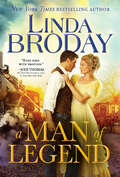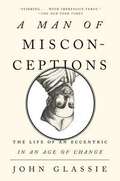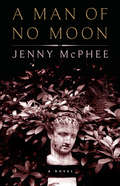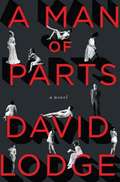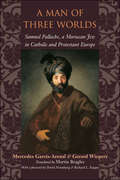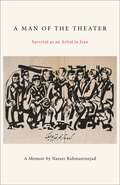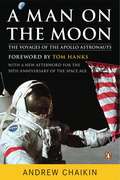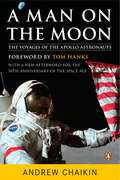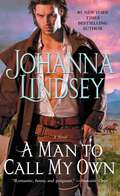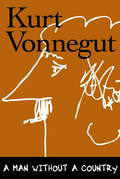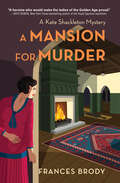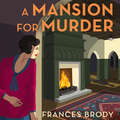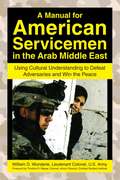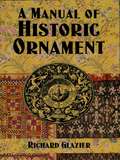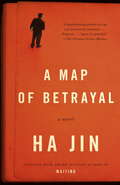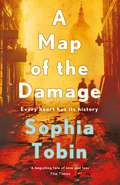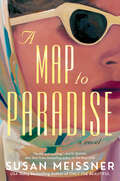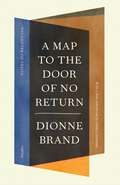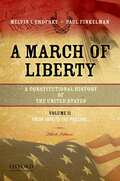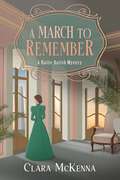- Table View
- List View
A Man of Legend (Lone Star Legends #3)
by Linda BrodayBestselling author Linda Broday sweeps readers back to the wild and untamed West, where men became the stuff of legend and family feuds could threaten the lives of two young lovers.Crockett Legend has always loved Paisley Mahone, but a family feud sure can ruin a romance. When her father turned against the powerful Legend clan, she took her family's side and broke Crockett's heart into pieces. Now her father's dead and Paisley and her last remaining brother are convinced the Legends are to blame.If only he can find a way to prove his innocence…A chance meeting throws the two warring hearts together, and when their train is held up by outlaws, Crockett and Paisley have to team up to save a young boy from dying. A tenuous truce is born. Together they may have a chance of bringing the truth to light…if they can get to the bottom of who's been trying to turn the two powerful families against each other. With so many secrets to unbury, it isn't long before Paisley finds herself in the crosshairs, but Crockett vows there'll be hell to pay if anyone hurts the woman he loves—or stands in the way of a Legend in the making."Runs deep with emotion."—Jodi Thomas, New York Times bestselling author, for Texas Mail Order Bride
A Man of Misconceptions
by John GlassieA Scientific American Best Science Book of 2012 An Atlantic Wire Best Book of 2012 A New York Times Book Review "Editor's Choice” The "fascinating” (The New Yorker) story of Athanasius Kircher, the eccentric scholar-inventor who was either a great genius or a crackpot . . . or a bit of both. The interests of Athanasius Kircher, the legendary seventeenth-century priest-scientist, knew no bounds. From optics to music to magnetism to medicine, he offered up inventions and theories for everything, and they made him famous across Europe. His celebrated museum in Rome featured magic lanterns, speaking statues, the tail of a mermaid, and a brick from the Tower of Babel. Holy Roman Emperors were his patrons, popes were his friends, and in his spare time he collaborated with the Baroque master Bernini. But Kircher lived during an era of radical transformation, in which the old approach to knowledge-what he called the "art of knowing”- was giving way to the scientific method and modern thought. A Man of Misconceptions traces the rise, success, and eventual fall of this fascinating character as he attempted to come to terms with a changing world. With humor and insight, John Glassie returns Kircher to his rightful place as one of history’s most unforgettable figures. .
A Man of No Moon: A Novel
by Jenny McPheeIt's 1948, and postwar Rome is giddy and chaotic. Poet Dante Sabato is attending yet another film industry soirée at Tullio Merlini's apartment off the Via del Corso. Disaffected and deeply self–absorbed, Dante finds Tullio's glamorous evenings tedious but welcomed any distraction. This raining evening, the distraction is double: sisters Gladys and Prudence Godfrey, both beautiful, sharp–witted, and remarkably compelling American actresses who have recently arrived in Rome. This new acquaintances leave the party together, and so begins a story of three damaged people struggling to live with their memories, and with themselves. Exhausted by fascism and the Second World War, Dante finds refuge in the hope offered by the resurgent cinema, by American literature, and, in particular, by the pragmatic optimism and sexual energy of his American lovers. But after decades of struggling to defend the fallibility of his art, his nation, his family, and his own humanity, he remains convinced that the best expression of hope is to give up his life. The question for Dante is: Can Gladys and Prudence change his mind? Will he let them?
A Man of Parts
by David LodgeThe mind is a time machine that travels backwards in memory and forwards in prophecy, but he has done with prophecy nowa' Sequestered in his blitz-battered house on the rim of Regent's Park, as the second war he has lived through moves into its final phase, the ailing Herbert George Wells, 'H. G. ' to his family and friends, looks back on a life crowded with incident, books, and women. Has it been a success or a failure?Once he was the most famous writer in the world, 'the man who invented tomorrow'; now he feels like yesterday's man, deserted or disparaged by readers, and depressed by the collapse of his utopian dreams for mankind. He recalls his unpromising start in life, and early struggles to acquire an education and make a living; his meteoric rise to fame as a writer with a prophetic imagination and a comic common touch, which brought him into contact with most of the important literary, intellectual, and political figures of his time; his plunge into socialist politics; his belief in free love, and energetic practice of it. Arguing with himself about his conduct, he relives his relationships with two wives and many mistresses, especially the brilliant student Amber Reeves and the gifted writer Rebecca West, both of whom bore him children, with dramatic and long-lasting consequences. Unfolding this astonishing life story, David Lodge achieves a riveting portrait of a man who embodied as many contradictions as he had talents: a socialist who enjoyed his affluence, a Darwinian evolutionist imbued with religious idealism, an acclaimed novelist who turned against the literary novel; a feminist womaniser, sensual yet incurably romantic, irresistible and exasperating by turns to those who knew him personally, but always vitally human.
A Man of Three Worlds: Samuel Pallache, a Moroccan Jew in Catholic and Protestant Europe
by Mercedes García-Arenal Gerard WiegersIn the late fifteenth century, many of the Jews expelled from Spain made their way to Morocco and established a dynamic community in Fez. A number of Jewish families became prominent in commerce and public life there. Among the Jews of Fez of Hispanic origin was Samuel Pallache, who served the Moroccan sultan as a commercial and diplomatic agent in Holland until Pallache's death in 1616. Before that, he had tried to return with his family to Spain, and to this end he tried to convert to Catholicism and worked as an informer, intermediary, and spy in Moroccan affairs for the Spanish court. Later he became a privateer against Spanish ships and was tried in London for that reason. His religious identity proved to be as mutable as his political allegiances: when in Amsterdam, he was devoutly Jewish; when in Spain, a loyal converso (a baptized Jew).In A Man of Three Worlds, Mercedes García-Arenal and Gerard Wiegers view Samuel Pallache's world as a microcosm of early modern society, one far more interconnected, cosmopolitan, and fluid than is often portrayed. Pallache's missions and misadventures took him from Islamic Fez and Catholic Spain to Protestant England and Holland. Through these travels, the authors explore the workings of the Moroccan sultanate and the Spanish court, the Jewish communities of Fez and Amsterdam, and details of the Atlantic-Mediterranean trade. At once a sweeping view of two continents, three faiths, and five nation-states and an intimate story of one man's remarkable life, A Man of Three Worlds is history at its most compelling.
A Man of the Theater: Survival as an Artist in Iran
by Nasser RahmaninejadLife in Iran as an artist under the Shah and during the Iranian RevolutionA Man of the Theater tells the personal story of a theater artist caught between the two great upheavals of Iranian history in the 20th century. One is the White Revolution of the 1960s, the incomplete and uneven modernization imposed from the top by the dictatorial regime of the Shah, coming in the wake of the overthrow of the popular Mosaddegh government with the help of the CIA. The other one is the Iranian Revolution of 1979, a great rising of Iranian society against the rule of the Shah in which Khomeini’s Islamist faction ends up taking power. Written in a simple direct style, Rahmaninejad’s memoir describes his fraught creative life in Tehran during these decades, founding a theater company and directing plays under the increasing pressure of the censorship authorities and the Shah’s secret police. After being arrested and tortured by the SAVAK and after spending years in Tehran’s infamous Evin prison and being a cause célèbre of Amnesty International, Rahmaninejad is freed by the Revolution of 1979. But his new-found freedom is short-lived; the progressive intellectuals and artists find themselves overpowered and outmaneuvered by the better organized Islamists, leading to renewed terror and to exile. In Western perception, the Iranian Revolution, which this year has its 40th anniversary, often overshadows the decades of Iran’s modern history that preceded it. A Man of the Theater fills this gap. The title derives from a time of torture in prison when interrogators ordered him to write everything about his activities. To avoid revealing anything incriminating he took pen in hand and wrote and wrote about all his artistic passions, beginning, "Here it is—this is my life! I am an artist! A man of the theater!"
A Man of the Theater: Survival as an Artist in Iran
by Nasser RahmaninejadLife in Iran as an artist under the Shah and during the Iranian RevolutionA Man of the Theater tells the personal story of a theater artist caught between the two great upheavals of Iranian history in the 20th century. One is the White Revolution of the 1960s, the incomplete and uneven modernization imposed from the top by the dictatorial regime of the Shah, coming in the wake of the overthrow of the popular Mosaddegh government with the help of the CIA. The other one is the Iranian Revolution of 1979, a great rising of Iranian society against the rule of the Shah in which Khomeini’s Islamist faction ends up taking power. Written in a simple direct style, Rahmaninejad’s memoir describes his fraught creative life in Tehran during these decades, founding a theater company and directing plays under the increasing pressure of the censorship authorities and the Shah’s secret police. After being arrested and tortured by the SAVAK and after spending years in Tehran’s infamous Evin prison and being a cause célèbre of Amnesty International, Rahmaninejad is freed by the Revolution of 1979. But his new-found freedom is short-lived; the progressive intellectuals and artists find themselves overpowered and outmaneuvered by the better organized Islamists, leading to renewed terror and to exile. In Western perception, the Iranian Revolution, which this year has its 40th anniversary, often overshadows the decades of Iran’s modern history that preceded it. A Man of the Theater fills this gap. The title derives from a time of torture in prison when interrogators ordered him to write everything about his activities. To avoid revealing anything incriminating he took pen in hand and wrote and wrote about all his artistic passions, beginning, "Here it is—this is my life! I am an artist! A man of the theater!"
A Man on the Moon: The Voyages Of The Apollo Astronauts
by Andrew Chaikin Tom HanksWhen astronauts Neil Armstrong and Buzz Aldrin took their 'giant leap for mankind' across a ghostly lunar landscape, they were watched by some 600 million people on Earth 240,000 miles away. <p><p> Drawing on hundreds of hours of in-depth interviews with the astronauts and mission personnel, this is the story of the twentieth century's greatest human achievement, minute-by-minute, through the eyes of those who were there. <p> From the tragedy of the fire in Apollo 1 during a simulated launch, Apollo 8's bold pioneering flight around the moon, through to the euphoria of the first moonwalk, and to the discoveries made by the first scientist on the moon aboard Apollo 17, this book covers it all.
A Man on the Moon: The Voyages of the Apollo Astronauts
by Andrew Chaikin"The authoritative masterpiece" (L. A. Times) on the Apollo space program and NASA's journey to the moonThis acclaimed portrait of heroism and ingenuity captures a watershed moment in human history. The astronauts themselves have called it the definitive account of their missions. On the night of July 20, 1969, our world changed forever when Neil Armstrong and Buzz Aldrin walked on the moon. Based on in-depth interviews with twenty-three of the twenty-four moon voyagers, as well as those who struggled to get the program moving, A Man on the Moon conveys every aspect of the Apollo missions with breathtaking immediacy and stunning detail.A Man on the Moon is also the basis for the acclaimed miniseries produced by Tom Hanks, From the Earth to the Moon, now airing and streaming again on HBO in celebration of the 50th anniversary of Apollo 11.
A Man to Call My Own: A Novel (Bride Series)
by Johanna LindseyFrom #1 New York Times bestselling author Johanna Lindsey comes a love story as passionate and tumultuous as the old American West, about an heiress who discovers passion in the arms of a Texas cowboy.Amanda and Marian Laton are identical twins but they are as different as night and day. Amanda is beautiful but nasty, and Marian is kind but plain—purposely so to avoid provoking her spiteful twin's jealousy. When their wealthy father suddenly dies, the two gently reared New England heiresses are sent to live with their aunt on a sprawling Texas ranch. There the twins meet Chad Kinkaid, the cowboy son of a neighboring rancher. Marian is fascinated by Chad's rugged good looks and his sheer masculinity, but she knows that like every other man she and her twin have met, he will pursue Amanda, not her. Chad is indeed beguiled by Amanda's beauty, but soon he begins to see beyond Marian's carefully constructed dowdy façade. Unlike the tame gentlemen back East, after witnessing Marian's taste for adventure, her sense of humor and bravery in the face of danger, Chad finds himself wanting her. But how can he, a man who's just a cowboy without fancy airs or urbane charm, convince her she's the only woman for him?
A Man without a Country
by Kurt Vonnegut Jr. Daniel SimonA Man Without a Country is Kurt Vonnegut's hilariously funny and razor-sharp look at life ("If I die--God forbid--I would like to go to heaven to ask somebody in charge up there, 'Hey, what was the good news and what was the bad news?"), art ("To practice any art, no matter how well or badly, is a way to make your soul grow. So do it."), politics ("I asked former Yankees pitcher Jim Bouton what he thought of our great victory over Iraq and he said, 'Mohammed Ali versus Mr. Rogers.'"), and the condition of the soul of America today ("What has happened to us?"). Based on short essays and speeches composed over the last five years and plentifully illustrated with artwork by the author throughout, A Man Without a Country gives us Vonnegut both speaking out with indignation and writing tenderly to his fellow Americans, sometimes joking, at other times hopeless, always searching.
A Man's Reach
by Elmer L. Andersen Lori SturdevantAutobiography of the popular Minnesota Governor in the 1950's.
A Mansion for Murder: A Kate Shackleton Mystery (A Kate Shackleton Mystery #13)
by Frances BrodyOld bones speak from the grave as a curse descends on Saltaire in acclaimed author Frances Brody&’s thirteenth Kate Shackleton mystery, perfect for fans of Rhys Bowen and Jacqueline Winspear.When Kate Shackleton disembarks at Saltaire station, in the West Riding of Yorkshire, she has no idea what to expect. A stranger, Ronnie Creswell, has written to say that he has urgent information about the past that will interest her, and he persuades her to make the journey to Milner Field, the grand house that is said to be cursed. But moments after Kate arrives at the lodge, a messenger brings devastating news to Ronnie&’s parents: he has been found drowned in the mill reservoir. Ronnie&’s father suspects that this was no accident, and the post-mortem proves him right. Ronnie was murdered. Terrified and distraught, Mrs. Creswell refuses to stay at the Lodge a moment longer. But events take an even more shocking turn when ten-year-old Nancy Creswell, eyes and ears for her blind Uncle Nick, goes missing. An account of the fateful Saturday of Ronnie&’s death arouses Kate&’s suspicions, and furhter investigations could prove her right. But truth is never so straightforward at Milner Field. Uncle Nick spins an old story that could hold the key to finding Nancy alive—though the fabled curse may not have claimed its last victim yet. And only a set of old bones buried on the grounds will finally reveal the horrifying truth.
A Mansion for Murder: Book 13 in the Kate Shackleton mysteries (Kate Shackleton Mysteries #13)
by Frances BrodyThe brand new novel featuring Private Investigator Kate Shackleton!1930, Yorkshire. Intrigued by a mysterious letter from a stranger offering important information, Private Investigator Kate Shackleton arrives in the mill village of Saltaire. At nearby Milner Field mansion, overshadowed by its reputation for misfortune and untimely deaths, she expects to meet the letter writer, Ronnie Creswell.Kate soon hears the shocking news that Ronnie has been killed. At first his death appears to be a tragic accident at the mill, but soon it becomes clear that Ronnie's demise was no mishap. Kate is enlisted to help investigate the murder.Kate moves into the tower rooms at Milner Field, as she tries to uncover resentments, industrial espionage, and old secrets in the close-knit village. Although she doesn't believe in curses, she wonders what sinister truth lies behind this latest in the litany of deaths connected to the infamous Milner Field.Then just when things couldn't get any worse, a young girl in the village goes missing, and Kate must use all her strength and skill to unravel the mystery around the mansion once and for all . . .Whether you've read the whole series, or are discovering the Kate Shackleton mysteries for the first time, this is the perfect page-turner for fans of Agatha Christie, Ann Granger and Jacqueline Winspear.'Frances Brody has made it to the top rank of crime writers' Daily Mail'Brody's writing is like her central character Kate Shackleton: witty, acerbic and very, very perceptive' Ann Cleeves'Kate Shackleton is a splendid heroine' Ann Granger'Delightful' People's Friend
A Mansion for Murder: Book 13 in the Kate Shackleton mysteries (Kate Shackleton Mysteries #13)
by Frances BrodyThe brand new novel featuring Private Investigator Kate Shackleton!1930, Yorkshire. Intrigued by a mysterious letter from a stranger offering important information, Private Investigator Kate Shackleton arrives in the mill village of Saltaire. At nearby Milner Field mansion, overshadowed by its reputation for misfortune and untimely deaths, she expects to meet the letter writer, Ronnie Creswell.Kate soon hears the shocking news that Ronnie has been killed. At first his death appears to be a tragic accident at the mill, but soon it becomes clear that Ronnie's demise was no mishap. Kate is enlisted to help investigate the murder.Kate moves into the tower rooms at Milner Field, as she tries to uncover resentments, industrial espionage, and old secrets in the close-knit village. Although she doesn't believe in curses, she wonders what sinister truth lies behind this latest in the litany of deaths connected to the infamous Milner Field.Then just when things couldn't get any worse, a young girl in the village goes missing, and Kate must use all her strength and skill to unravel the mystery around the mansion once and for all . . .Whether you've read the whole series, or are discovering the Kate Shackleton mysteries for the first time, this is the perfect page-turner for fans of Agatha Christie, Ann Granger and Jacqueline Winspear.'Frances Brody has made it to the top rank of crime writers' Daily Mail'Brody's writing is like her central character Kate Shackleton: witty, acerbic and very, very perceptive' Ann Cleeves'Kate Shackleton is a splendid heroine' Ann Granger'Delightful' People's Friend
A Manual for American Servicemen in the Arab Middle East: Using Cultural Understanding to Defeat Adversaries and Win the Peace
by William D. WunderleThe Global War on Terrorism (GWOT) has sent U.S. diplomats and troops around the world. In the current security environment, understanding foreign cultures is crucial to defeating adversaries and working with allies. Lt. Col. William D. Wunderle explains how U.S. soldiers and commanders can look at military interventions-from preparation to execution-through the lens of cultural awareness, while always minding post-conflict stability operations. He also suggests much-needed changes to the traditional intelligence preparation of the battlefield (IPB) and the military decision-making process (MDMP). Fascinating, concise, and timely, this is a must-read for military personnel, the intelligence community, and anyone seeking to grasp the motivations and decision-making styles of people all over the globe.
A Manual of Historic Ornament
by Richard GlazierExceptionally comprehensive, easy-to-use guide surveys the evolution of historic ornament in architecture and the applied arts — from primitive ornaments of Oceania, Egypt, and Assyria to a Gothic doorway in Amiens, the tomb of Lorenzo de Medici, and a classic early-19th-century sofa by Thomas Hope. Over 700 black-and-white illustrations. 16 plates of photographs.
A Manuscript of Ashes: A Novel
by Antonio Muñoz MolinaIn this &“beautifully wrought&” novel set in Franco-era Spain, a university student stumbles into a decades-old mystery (New York magazine). It&’s the late sixties, the last dark years of Franco&’s dictatorship. Minaya, a university student in Madrid, is caught up in the student protests and the police are after him. He moves to his uncle Manuel&’s country estate in the small town of Mágina to write his thesis on an old friend of his uncle, an obscure republican poet named Jacinto Solana. The country house is full of traces of the poet—notes, photographs, journals—and Minaya soon discovers that, thirty years earlier, during the Spanish Civil War, both his uncle and Solana were in love with the same woman, the beautiful, unsettling Mariana. Engaged to Manuel, she was shot in the attic of the house on her wedding night. With the aid of Inés, a maid, Minaya begins to search for Solana&’s lost masterpiece, a novel called Beatus Ille. Looking for a book, he unravels a crime. One of Spain&’s most celebrated literary figures, the author of Sepharad and In the Night of Time weaves a &“rapturously gothic&” tale that is both a novel of ideas and an intricately plotted mystery (The New York Sun). &“A brilliant novel by an important writer unafraid of ideas, emotions and genuine beauty.&” —Los Angeles Times &“Already a contemporary classic, this work . . . is an enigmatic gem in the very best metafiction tradition.&” —Library Journal
A Map of Betrayal: A Novel
by Ha JinA Christian Science Monitor Best Book of the YearFrom the award-winning author of Waiting and War Trash: a riveting tale of espionage and conflicted loyalties that spans half a century in the entwined histories of two countries--China and the United States--and two families. When Lilian Shang, born and raised in America, discovers her father's diary after the death of her parents, she is shocked by the secrets it contains. She knew that her father, Gary, convicted decades ago of being a mole in the CIA, was the most important Chinese spy ever caught. But his diary, an astonishing chronicle of his journey as a Communist intelligence agent, reveals the pain and longing that his double life entailed--and point to a hidden second family that he'd left behind in China. As Lilian follows her father's trail back into the Chinese provinces, she begins to grasp the extent of his dilemma: he is a man torn between loyalty to his motherland and the love he came to feel for his adopted country. She sees how his sense of duty distorted his life, and as she starts to understand that Gary too had been betrayed, Lilian finds that it is up to her to prevent his tragedy from endangering yet another generation of Shangs. A stunning portrait of a multinational family and an unflinching inquiry into the meaning of citizenship, patriotism, and home, A Map of Betrayal is a spy novel that only Ha Jin could write.From the Hardcover edition.
A Map of Future Ruins: On Borders and Belonging
by Lauren Markham&“This stunning meditation on nostalgia, heritage, and compassion asks us to dismantle the stories we&’ve been told—and told ourselves—in order to naturalize the forms of injustice we&’ve come to understand as order.&” —Leslie Jamison, author of The Empathy Exams When and how did migration become a crime? Why does ancient Greece remain so important to the West&’s idea of itself? How does nostalgia fuel the exclusion and demonization of migrants today? In 2021, Lauren Markham went to Greece, in search of her own Greek heritage and to cover the aftermath of a fire that burned down the largest refugee camp in Europe. Almost no one had wanted the camp—not activists, not the country&’s growing neo-fascist movement, not even the government. But almost immediately, on scant evidence, six young Afghan refugees were arrested for the crime. Markham soon saw that she was tracing a broader narrative, rooted not only in centuries of global history but also in myth. A mesmerizing, trailblazing synthesis of reporting, history, memoir, and essay, A Map of Future Ruins helps us see that the stories we tell about migration don&’t just explain what happened. They are oracles: they predict the future.
A Map of the Damage
by Sophia TobinAlready a Sunday Times bestselling author with her first novel, A Map of the Damage confirms Sophia Tobin as a rising star. Stunning historical fiction for fans of Tracy Chevalier. London, 1941.Livy makes her way through Blitz-torn London to the Mirrormakers’ Club, the only place that makes her feels safe, where she finds herself drawn into the mystery of a missing diamond, and torn between two men with competing claims on her. London, 1841. Charlotte is helped from the scene of an accident by a man who shows her a building he is working on, and whose kindness unlocks a hope she has long kept buried. But that man is not her husband. Two women, a century apart, united by one place: the Mirrormakers’ Club. A building which holds echoes of past loves and hates, and hides the darkest of secrets in its foundations.Praise for The Vanishing ‘Undeniably page-turning’ Mail on Sunday 'Think Wuthering Heights or Jane Eyre, but ten times darker, and you have The Vanishing … as dark and eerie and gothic as the Yorkshire Moors it is set on. One to curl up by the fire with on a windy night’ Stylist ‘Entertaining’ Times ‘Vivid, absorbing and wonderfully gothic, with shades of Sarah Waters and Emily and Charlotte Brontë’ Kate Riordan ‘Brilliantly Brontë-esque. Perfect reading for a stormy night’ Anna Mazzola ‘A vivid sense of the period … which stays with the reader long after the final page’ the i ‘The plotting is skilful, with a network of lies being woven so that no one, characters or readers, can be sure of the truth’ Daily Express ‘Atmosphere aplenty and some real surprises’ Daily Mail ‘Echoes Wuthering Heights with its setting and sense of intrigue’ Red ‘An atmospheric tale of betrayal and revenge’ woman&home ‘A thrilling, atmospheric page-turner’ Metro
A Map to Paradise
by Susan Meissner1956, Malibu, California: Something is not right on Paradise Circle.With her name on the Hollywood blacklist and her life on hold, starlet Melanie Cole has little choice in company. There is her next-door neighbor, Elwood, but the screenwriter&’s agoraphobia allows for just short chats through open windows. He&’s her sole confidante, though, as she and her housekeeper, Eva, an immigrant from war-torn Europe, rarely make conversation.Then one early morning Melanie and Eva spot Elwood&’s sister-in-law and caretaker, June, digging in his beloved rose garden. After that they don&’t see Elwood at all anymore. Where could a man who never leaves the house possibly have gone? As they try to find out if something has happened to him, unexpected secrets are revealed among all three women, leading to an alliance that seems the only way for any of them to hold on to what they can still call their own. But it&’s a fragile pact and one little spark could send it all up in smoke…
A Map to the Door of No Return: Notes to Belonging
by Dionne BrandNow in its first American edition, Dionne Brand’s groundbreaking A Map to the Door of No Return has emerged as a modern classic, a highly influential exploration of “being” in the Black Diaspora.Since its first publication in 2001, Dionne Brand’s groundbreaking exploration of being in the Black Diaspora, A Map to the Door of No Return, has emerged as a modern classic. The door, in Brand’s iconic schema, represents the point of rupture where the ancestors of the Black Diaspora departed one world for another: the place where all names were forgotten, and all beginnings recast. “This door,” writes Brand, “is not mere physicality. It is a spiritual location . . . Since leaving was never voluntary, return was, and still may be, an intention, however deeply buried. There is as it says no way in; no return.” Through shards of history, memoir, lyrical investigation, and the unwritten experience of so many descendants of those who passed through the door, Brand constructs a map of this indelible region, culminating in an enduring expression, both definitive and seeking, of what it is to live, think, and create in the wake of colonization. With a new preface by the author, and an afterword by Saidiya Hartman.
A March of Liberty: A Constitutional History of the United States, Volume 2: From 1898 to the Present
by Paul Finkelman Melvin UrofskyA March of Liberty: A Constitutional History of the United States, Third Edition, is a clearly written, comprehensive overview of American constitutional development. Covering the country's history from the founding of the English colonies up through the latest decisions of the Supreme Court, this two-volume work presents the most complete discussion of American constitutional history currently available. Authors Melvin I. Urofsky and Paul Finkelman successfully blend cases and court doctrines into the larger fabric of American political, economic, and social history. They discuss in detail the great cases handed down by the Supreme Court, showing how these cases played out in society and how constitutional growth parallels changes in American culture. In addition, they examine lesser-known decisions that played important roles in affecting change, and also provide in-depth analyses of the intellects and personalities of the Supreme Court justices who made these influential decisions. Updated with the most recent scholarship, the third edition of A March of Liberty offers more cases on a broader range of issues including the environment, labor, civil rights, and Native American concerns. It now presents new selections on decisions, statutes, and constitutional developments from the first decade of the 21st century--like the USA PATRIOT Act, presidential signing statements, same-sex marriage, reproductive rights, campaign financing, and firearms regulation. The text reflects the current trends in American constitutional history by employing a holistic approach that integrates the decisions of the state and lower federal courts with the decisions of the Supreme Court. A March of Liberty, Third Edition, features useful supplemental materials including the text of the Constitution, a chronological list of Supreme Court justices, an appendix of the names and years for each Supreme Court justice, and suggested further readings. Gracefully written and clearly explained, this popular two-volume set is indispensable for courses in American constitutional history and law.
A March to Remember (A Hattie Davish Mystery #5)
by Clara McKennaTraveling secretary Hattie Davish is taking her singular talents to Washington, D.C., to help Sir Arthur Windom-Greene research his next book. But in the winding halls of the nation’s capital, searching for the truth can sometimes lead to murder . . . Hattie is in her element, digging through dusty basements, attics, and abandoned buildings, not to be denied until she fishes out that elusive fact. But her delightful explorations are dampened when she witnesses a carriage crash into a carp pond beneath the shadow of the Washington Monument. Alarmingly, one of the passengers flees the scene, leaving the other to drown. The incident only heightens tensions brought on by the much publicized arrival of “Coxey’s Army,” thousands of unemployed men converging on the capital for the first ever organized “march” on Washington. When one of the marchers is found murdered in the ensuing chaos, Hattie begins to suspect a sinister conspiracy is at hand. As she expands her investigations into the motives of murder and closes in on the trail of a killer, she is surprised and distraught to learn that her research will lead her straight to the highest levels of government . . . Praise for A Deceptive Homecoming “A well-written historical mystery that brought the period to life.”—Mystery Scene
